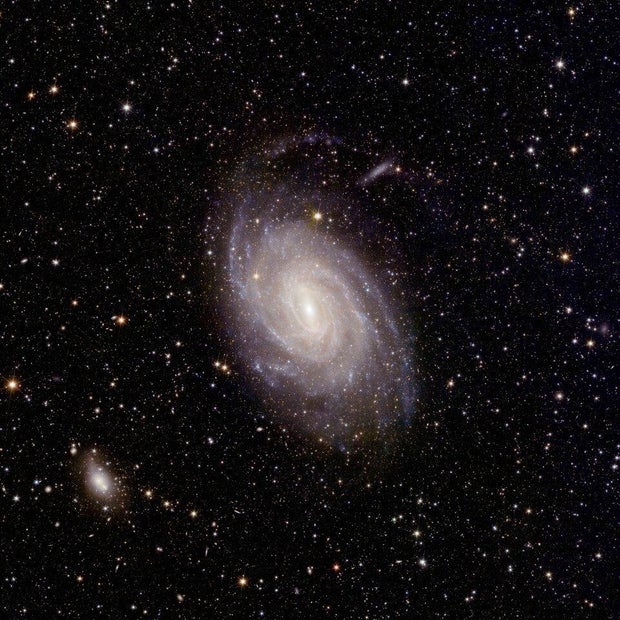An impressive number of bright galaxies, a purple and orange stellar nursery, and a spiral galaxy similar to our Milky Way: new images have been revealed from Europe’s Euclid Space Telescope on Thursday.
And the second set of images released by the European Space Agency since Euclid was launched last year on the first mission to investigate the mysteries of dark matter and dark energy.
“The never-before-seen images demonstrate Euclid’s ability to unlock the secrets of the cosmos and allow scientists to hunt rogue planets, use lensed galaxies to study mysterious matter and explore the evolution of the universe,” the European Space Agency said in a statement. The declaration.
Euclid’s science data was also published for the first time in the six-year mission, which aims to use its broad view to map two billion galaxies across a third of the sky.
Euclid project scientist Rene Laureijs told AFP he was “personally very excited” about the image of a huge galaxy cluster called Abell 2390. The image of the cluster, which is 2.7 billion light-years away from Earth, encompasses more than 50,000 galaxies.
ESA
Just one galaxy – like ours – can house hundreds of billions or even billions of stars, each of which could be larger than the Sun.
In Abell 2390, Euclid was able to detect the faint light of “orphan stars” drifting between galaxy clusters, said Jean-Charles Cuillandre, a French scientist who works on Euclid.
These stars are ejected from the galaxies, “creating a kind of cloud that surrounds the entire cluster,” Cuillandre told AFP.
According to astronomers, this strange phenomenon points to the presence of dark matter between galaxies.
Dark matter and dark energy are believed to make up 95% of the universe – but we know almost nothing about them.
Euclides also captured the deepest image ever of Messier 78, a star-born nursery 1,300 light-years from Earth in the constellation Orion.
ESA
The stars are still in the process of forming in the bluish center of the image. After gestating for millions of years, they emerge from the purple and orange clouds at the bottom of the image. “Brilliant things are trying to emerge,” Cuillandre said.
Laureijs emphasized that “only Euclid can show this at once.”
This is because Euclid has a very wide field of view, in contrast to the far-viewing James Webb space telescope, its neighbor on a stable floating point 15.3 million kilometers from Earth.
Another image, of the huge galaxy cluster Abell 2764, shows a black expanse in which a yellow star stands out.
Cuillandre admitted that this was the result of an error in pointing the telescope. But he said the image demonstrated “Euclid’s absolutely unique ability to concentrate light” because he was still able to pick up very faint objects close to the bright star.
Euclid’s image of the young Dorado cluster contained a surprise. Although the cluster has already been well studied, Euclid discovered a never-before-seen dwarf galaxy, scientists said.
“I’ve never seen anything like it,” Cuillandre said.
In the fifth new image, the spiral galaxy NGC 6744 – which bears a striking resemblance to the Milky Way – sprawls against a backdrop of bright stars.
ESA
It is still early for the mission and the five new images were captured in just one day.
In the coming years, scientists plan to examine Euclid’s data in hopes of detecting all types of celestial bodies, such as “rogue” planets, that float freely through the universe without connection to a star.
But researchers are already analyzing the first batch of Euclides images, released in November.
In one of 10 preprint studies published Thursday, scientists analyzed the faint light emitted by orphan stars in the Perseus galaxy cluster.
These lost stars “are now trapped in the gravity of dark matter,” Laureijs said.
This remains only an “indirect detection of dark matter”, he emphasized, adding that it is too early “to say anything about dark energy”.
An image released last year showed a spectacular wide-angle view of Perseus, revealing at least 1,000 gravitationally bound galaxies, with another 100,000 or more scattered across the more distant background – many of them never seen before.
The mission was not entirely smooth.
In March, a delicate operation successfully melted a thin layer that was clouding the telescope’s view by heating one of the telescope’s mirrors.
There are signs that the ice is accumulating again, Laureijs said, adding that the team has time to investigate what to do next.
Launched from Cape Canaveral on July 1, 2023 atop a SpaceX Falcon 9 rocket, the $1.5 billion Euclid is parked about a million miles from Earth, on the far side of the Moon’s orbit.
Over the course of its six-year mission, the observatory will image the entire sky around the Milky Way, monitoring galaxies and galaxy clusters dating back 10 billion years.
“The images and associated scientific discoveries are impressively diverse in terms of objects and distances observed. They include a variety of scientific applications and yet represent only 24 hours of observations. They give just a hint of what Euclid could do,” Valeria Pettorino, ESA Euclid Project Scientist, said in a statement on Thursday. “We look forward to six more years of data!”
William Harwood contributed to this report.


























